Wildlife in Italy
in Maremma's woodlands and Mediterranean macchia
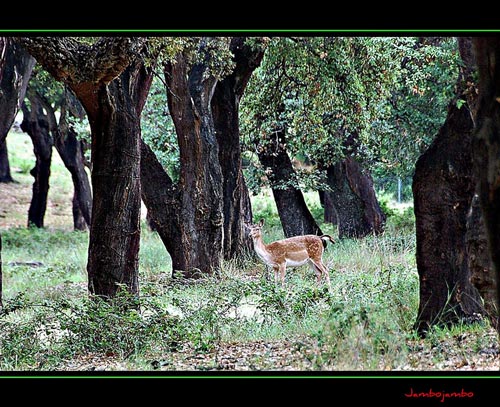
The wonderful wildlife in Italy that you will find in and along the margins of the Mediterranean macchia and woodlands of Maremma, Tuscany: wild animals that will catch your breath when you first spot them - sometimes in disbelief that you could be so close - as you walk or drive through the lanes or pathways in Maremma's very special countryside, national parks, reserves and wildernesses. Areas of outstanding natural beauty.
A visit to undiscovered Maremma in Tuscany and Lazio will be an experience that you will never forget. Ever seen a female wild boar and her litter of nine or ten piglets foraging for food in the early evening?
On your drive back to your holiday accommodation keep an eye out alongside the edges of the copses and woodlands and I can practically guarantee that you will! Turn down a country lane on your bike and you will catch a glimpse of a hare or two.
Return home in the dark and you will have to keep all eyes peeled so as to avoid colliding with a deer, a crested porcupine, badger or wild pig. I drive these roads a lot at dusk and in the dark and always see one, if not two or three of these animals before reaching home!
The beautiful wildlife in Italy nature photograph above is by kind permission of JamboJambo.
The Tuscany wildlife in Maremma
Strange and fun animal facts for kids
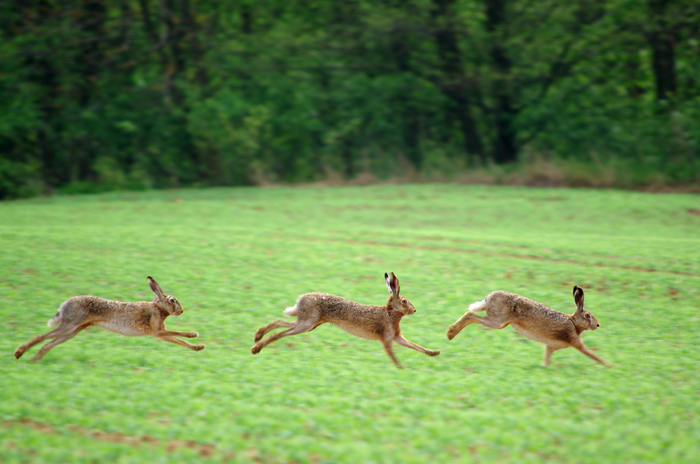 Photo by Jakub Halun. License.
Photo by Jakub Halun. License.Here are some fun and sometimes strange facts about Maremma's wild animals that are great for kids. Strange and fun animal facts for kids.
The Badger
Tasso - Meles meles
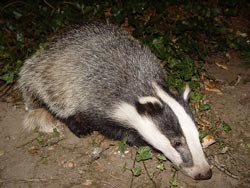 |
Wildlife in Italy: Tasso (Badger Hero) |
Largely nocturnal, the black and white masked badger spends the day inside its burrow digging tunnels in the forest. It prefers to live where Maremma's forests are interspersed with open areas and meadows and feeds mainly on earthworms, but also small vertebrates such as moles, voles, frogs and small snakes, as well as fruit, bulbs and acorns.
They have an acute sense of smell, but can only see in black and white.
Their "tana" - den - may be home to more than one family and will be used for generations, each one tending to expand the galleries and tunnels a little more. And they sometimes share it with red foxes and rabbits, although the badger will throw out their guests if they become annoying or overstay their welcome!
Spot them at night-time crossing country roads.
The Edible Dormouse
Ghiro - Myoxus glis
 |
Wildlife in Italy: Ghiro (Marcus Ostermann) |
The edible dormouse lives in Maremma's plains, hills and mountains, parks, gardens, orchards, and deciduous trees, especially oak trees. It can weigh up to 250 grams and grows up to 20 cm long with a 15 cm long tail.
It is a slim mouse with a round head and bulging eyes and a long, bushy tail. Its coat is a grey-brown colour, with a white to buff underbelly. Its tail is darker than that of the fur on its back.
It feeds mainly on plants and sometimes eggs and nestlings and spends much of its day in nests of birds that it has stolen or tree hollows.
It is a nocturnal mouse and it lives in family groups, but is not a very sociable animal. From October to April it goes into hibernation in holes in the soil to a depth of 50 to 60 cm in warm nests lined with plant material.
Its tail acts as a stabilizer when it is moving around, and is wrapped around its body when it is resting.
The Red Fox
Volpe - Vulpes vulpes
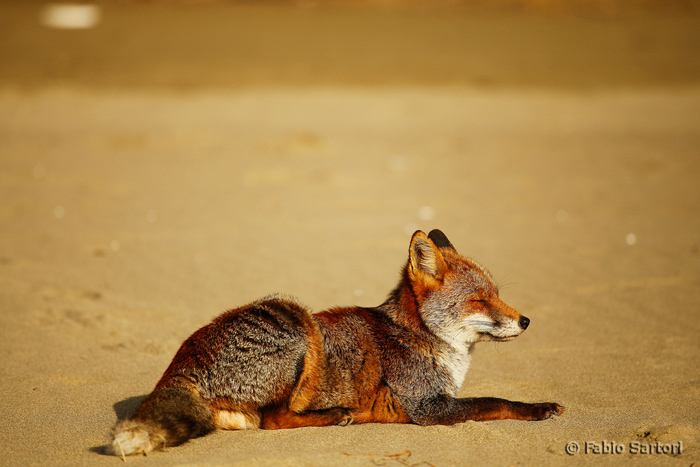 Tuscany's beautiful red fox sunning itself on a Maremma beach.
Tuscany's beautiful red fox sunning itself on a Maremma beach.Photo by kind permission of Fabio Sartori.
Maremma's red foxes hide in their own burrows or those of other animals they have usurped.
If undisturbed they walk at a tranquil trot, but if pursued they can run very fast with great endurance, jumping obstacles of every kind and swimming across fast flowing water, even of considerable width.
A great place to see them is the Parco Naturale della Maremma at Alberese, where this photo was taken.
They will eat almost any animal that they can kill, as well as insects, earthworms, fruit and poultry. And once they have found their food they very rarely give it up, even to larger stronger animals.
Their contact calls during the winter months of December to February are a "wow wow wow" sound - often mistaken for the territorial call of the tawny owl.
The Hare
Lepre - Lepus europaeus
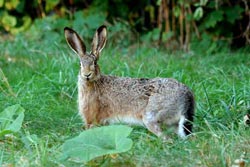 |
Wildlife in Italy: Lepre (Fmickan) |
Although hares have mainly nocturnal habits, you can often spot them in the middle of fields in Maremma during daylight. Weighing between 2.5 kg and 6kg, with a body length of up to 70 cm, they are readily distinguished from their rabbit "cousins" by their wonderful long ears.
Unlike the rabbit, the hare doesn't dig a burrow, bur prefers natural depressions in the ground for its lair. It eats grasses, roots and various vegetables, and in turn is eaten by foxes, buzzards, crows, and stray dogs and cats.
When it returns to its lair, the hare jumps the last length - up to three metres long - so as not to leave any tracks and shake off any following predators.
The hare is a runner of great resistance and speed, reaching up to 80 kilometers per hour. At its top speed it does a jump! of up to four metres.
 Hares in Tuscany. Photo by Frebeck. License.
Hares in Tuscany. Photo by Frebeck. License.
The Hedgehog
Riccio - Erinaceus eurpaeus
The hedgehog is found all around Maremma in forests, forest edges, fields, parks, gardens, hedges, and bushes. It has a stout and round body with a mobile snout, pointed round eyes, and short rounded ears almost entirely hidden in its fur.
Its dense spines, each of which are attached to a muscle that allows it to stand them upright and lower them, are continually being shed and replaced.
It feeds on worms, snails, millipedes, beetles, frogs, small reptiles, young birds, mice, acorns, and berries. A solitary animal except during mating season, it is active from dusk until early morning moving a distance of between one and two kilometres. Did you know it is a good swimmer and climber?
When it feels in danger, the hedgehog rolls itself up, straightening its spines so that they intersect with each other forming a nearly impenetrable mass.
It has several dens during the summer and winter, and in its last one it hibernates from October to April. Its winter nest is made of grass and leaves, which give him better protection against intemperate weather conditions and lasts longer. When making his nest, the hedgehog collects a few leaves in his mouth at a time and places them where he intends to build. When he has as many he needs he starts adding each one to the centre of the structure, holding them steady with twigs. Once completed, he spins in circles flattening the leaves and forming walls thick as 10 cm deep.
The Pole Cat
Puzzola - Mustela putorius
 |
Wildlife in Italy: Puzzola (David Castor) |
You are most likely to see Maremma's pole cat in the forests and fields. But it also likes to live in houses, barns and stables.
It has an elongated body, with a flattened head, small eyes and small ears that slightly protrude from its thick reddish-brown fur, a long and bushy tail, and a black mask around his eyes like the raccoon. It is a slender animal with short legs and a hopping gait that is more effective and faster than it appears.
As a carnivore it prefers prey such as rodents and rabbits, even ones larger than itself, but in the event of shortage of food it will feed on insects and fruit even though it finds these difficult to digest. Its sense of vision, however, is not very acute and it mainly uses its sense of smell to hunt and kill prey.
The pole cat is a primarily nocturnal and solitary animal, although sometimes the female will go in search of food with her cubs during the day.
It has anal glands that emit a strong, unpleasant odour when it is excited or threatened.
The Crested Porcupine
Istrice - Hystrix Cristata
The crested porcupine is a nocturnal and monogamous animal that gets its name from the long black to grey quills that run along the top of its head, nape and down its back which it can raise - normally in defense when disturbed - into an impressive crest.
It is Italy's largest rodent measuring about 70 cm long and weighing up to 15 kg. A protected species and with no natural enemies, it is still relatively common, despite being victim to poachers.
Its back and sides are covered in long distinctive black and white striped spines which are sturdier than its shorter thicker body bristles and crest quills, but which aren't firmly attached. It is these, that if threatened at a short distance, the crested porcupine will attempt to stab into its opponent by charging backwards. Contrary to popular belief, the crested porcupine cannot launch its quills at a disturber.
The porcupine digs large burrows among rocks and tree stumps and feeds on plants, roots, tubers, fruits, and even gnaws the bark of trees.
I will never forget the first time I saw one of these magnificent animals: it was late in the evening on a drive back from Florence through the hills above Montieri and as we turned a bend there it was all lit up black and white and huge! So be advised. Take it slow on Maremma's roads at night.
Roe Deer
Capriolo - Capreolus capreolus
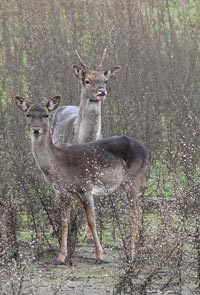 |
Wildlife in Italy: Capriolo by alisonhulot |
Found in Maremma's forests of mixed hardwoods with thick undergrowth, interspersed with meadows and cultivated fields.
A slender animal with an average weight of 25 kg and a height of approximately 70 cm to 80 cm. The roe deers coat in summer is a reddish in colour with lighter lower parts, changing in winter to a grey-brown.
It feeds on buds, leaves and grasses and in winter the tips of wood. Prefering in the spring and summer fodder grasses and legumes in particular. It is preyed upon by wolves, foxes, wild cats and the golden eagle.
You are most likely to see a female with her daughters at dusk feeding close to edges of Maremma's woodlands, but you can also see them in groups of about four to ten with the males in the Parco Naturale della Maremma.
And. Having an early morning chat with the local farm life!
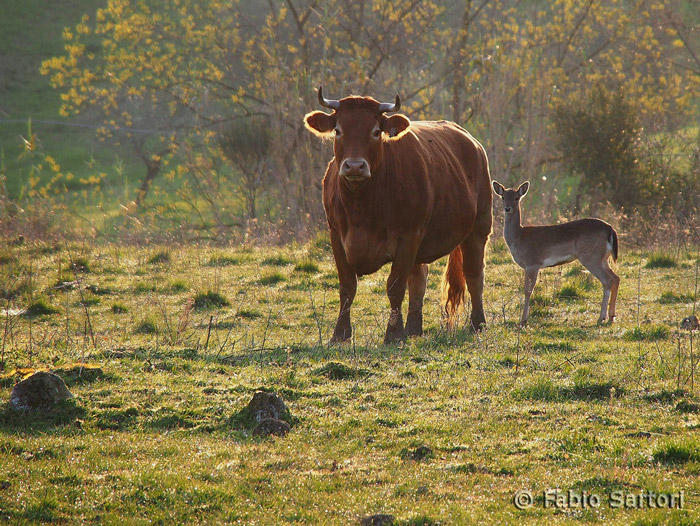 Wildlife in Italy: early morning conversations on Maremma's farms.
Wildlife in Italy: early morning conversations on Maremma's farms.Photo by kind permission of Fabio Sartori.
The Stone Marten
Faina - Martes foina
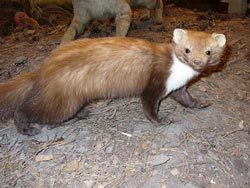 |
Wildlife in Italy: Faina (Franco Atirador) |
The stone marten has primarily nocturnal habits. It lives alone or in a family that dissipates at the end of the training of its young to hunt for themselves. Capable of jumping, it climbs easily on trees and buildings but usually lives on the ground. It rarely swims.
A weak digger, it frequents cavities and the burrows of other animals and often takes refuge in the hollows of trees, or in sinuous rock crevices as well as in barns, attics and buildings that are not too crowded.
It feeds on various small animals such as insects, amphibians, birds and their eggs, mice, dormice, and domestic pets. And is capable of opening its jaw beyond a 90 degree angle allowing it to transport big prey and large eggs without breaking them.
It has scent glands located in its paws, on its belly and around the anal region, which it uses to mark its territory. It moves with an odd gait giving rise to a parallel set of fingerprints in which the trace of the hind legs coincides with that of the front.
It lives for between 5 to 10 years.
The Least Weasel
Donnola - Mustela nivalis
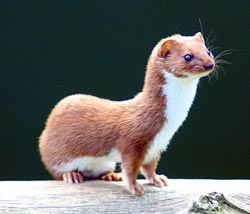 |
Wildlife in Italy: the Donnola (Kevin Law) |
Maremma's weasel can be seen in many places; the plains, hills and mountains, in cultivated land, the forests, bushy areas, and in abandoned houses. It can weigh up to 150 grams and with its 7cm long tail reaches a length of up to 32 cm.
A slender animal, it has a dense, soft fur dominantly yellow-brown in colour, with a tail that is uniform in color and a white underbelly.
It feeds on rodents and also hares, rabbits, birds and their eggs, reptiles and amphibians. It is eaten by birds of prey and other carnivores. Mainly nocturnal, it is a very lively animal and lives solitary or in small family groups, taking refuge in burrows dug by other animals.
The nest is constructed of hay, straw and piles of stones and wood and can be found between tree roots and in their cavities.
Wild Boar
Cinghiale - Sus scrofa
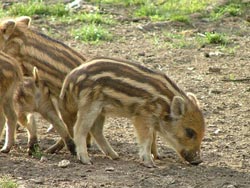 |
Wildlife in Italy: Cinghiale |
The ancestor of domesticated pigs, Maremma's wild boar are covered with a thick bristly, usually greyish-brown, fur. As adults they can reach 80 to 90 cm in height and weigh between 50 and 180 kg.
Both the upper and lower incisors in the males form into the distinctive long upward bending tusks.
Active at dusk and at night, they are omnivorous and feed on berries, roots, tubers, acorns, beech nuts, fruits, and also snails, worms and insects, small vertebrates, eggs of birds that nest on the ground and dead animals.
They live in sounders of about twenty animals led by the eldest female sows. Adult males are solitary with the exception of during winter, when mating occurs. The piglets up until six months old have a reddish coat with yellow longitudinal stripes
Find out lots more with 175 wild boar facts.
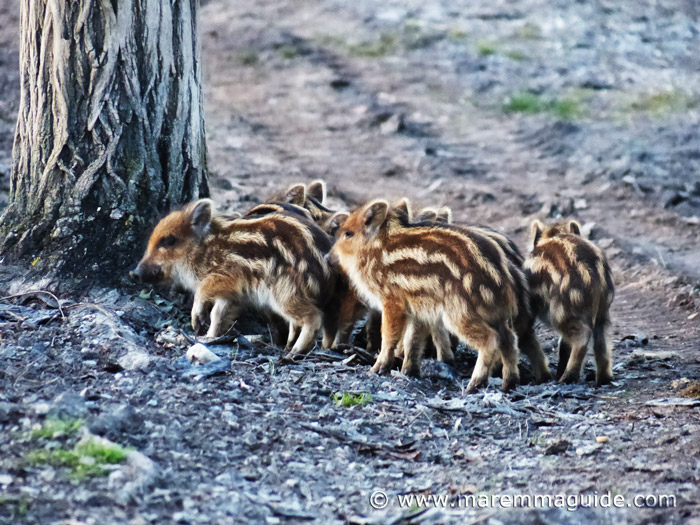
Wildlife in Italy: the snakes you might see
 |
Wildlife in Italy: Biscia dal collare - the Grass Snake. Natrix natrix (Fafner) |
Want to know what snakes you might see during your walks in Maremma? There aren't many - thank goodness as I don't like them one bit! - and only one poisonous one. This page (which I didn't like typing out! or looking at the pictures...) will tell you about them: snakes in Italy.
Explore some more...
- Go from wildlife in Italy to the fun and strange animal facts for kids


















